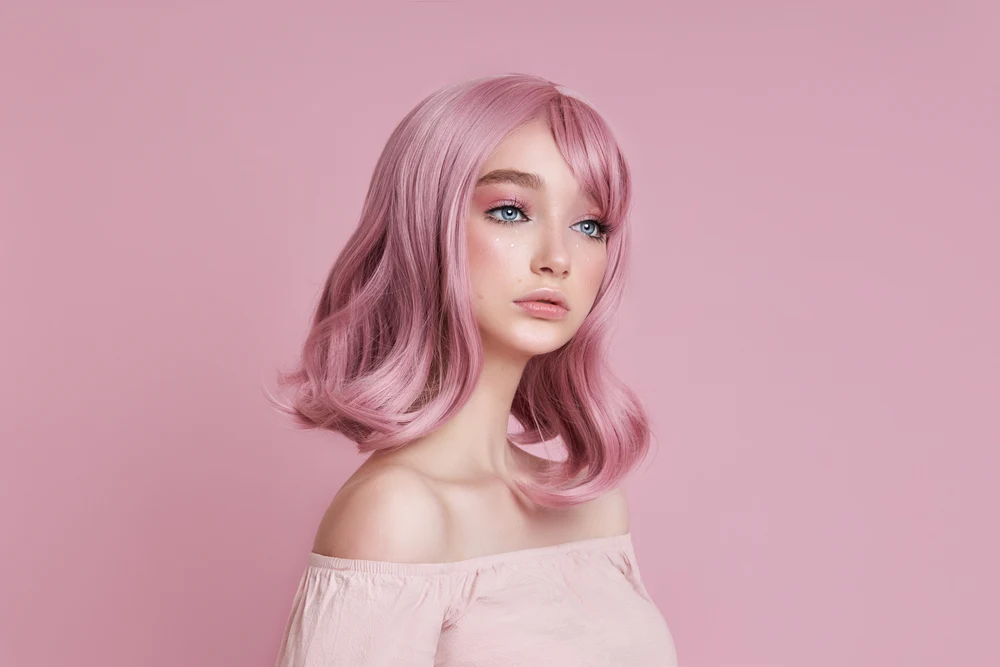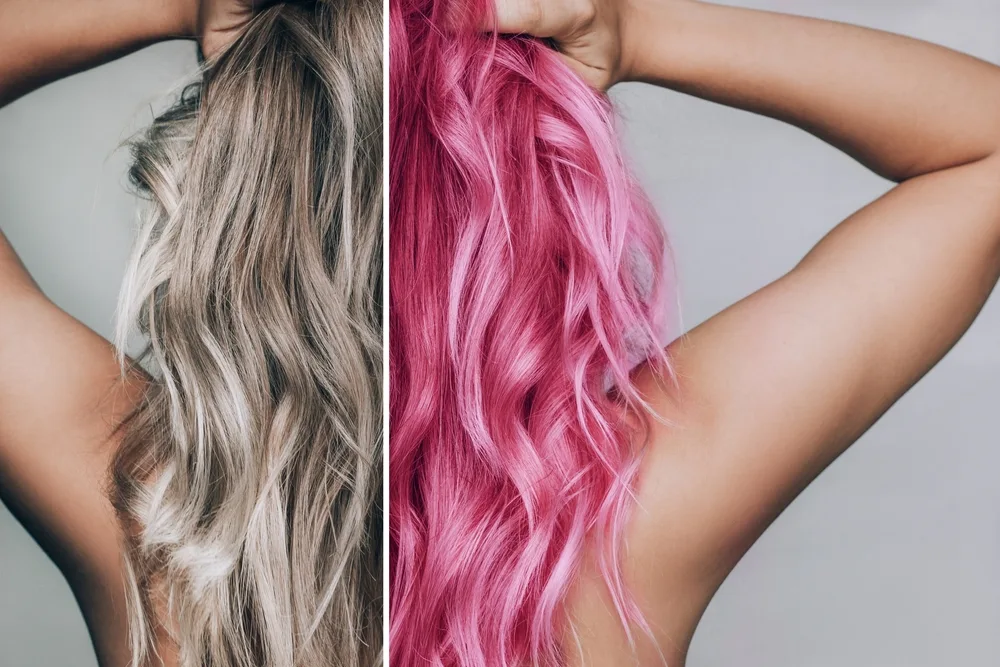Jump to:
Pink hair can be fun, but sometimes you want something new. Perhaps you never meant to have pink hair, but it accidentally turned pink after toning or bleaching.
Cancelling Out Pink Tones in Hair: A Summary

IvaFoto/Shutterstock
There are a few ways to lift pink tones from hair. You should consider the below methods based on how much pink is in your hair and what result you’re looking for.
- Clarifying Shampoo
- Green Shampoo
- Green semi-permanent hair dye
- Bleach
- Vitamin C and Shampoo
No matter what you choose, it’s easy to remove unwanted pink pigment using any of these techniques.
How to Remove Pink Tones From Hair 5 Ways
When reviewing the pink-removal methods, here there are some things to remember. If you want to safely and effectively remove your hair’s pink undertones, please review each process carefully.
All of the techniques listed here have varying side effects on your hair which we’ll discuss in-depth in each section. For example, bleach can cause hair damage if you bleach your hair often. Some methods won’t work as well as others if your hair is very pink vs. a little pink.
That said, each of these will work in lightening and completely removing pink tones in the hair. If you read each method carefully, you’ll find one that works for you.
1. Clarifying Shampoo
Use a clarifying shampoo if you have very light pink tones in your hair. If you have some leftover pink from a previous dye job, clarifying shampoo should be able to strip it. Even if it doesn’t completely remove the pink, it should lighten it enough to dye over or be unnoticeable.
Clarifying shampoos work best on a color that’s been deposited onto hair. So if you used a colored conditioner to get your current color, and it isn’t too dark, this should be all you need.
There is vital information to keep in mind when using a clarifying shampoo:
- You shouldn’t use it like a regular shampoo. It’s suitable for use every few months to remove product buildup and start fresh.
- Overusing a clarifying shampoo will dry out and even damage hair by stripping nutrients.
- If only part of your hair is pink, and the rest has another coloring in it, clarifying shampoo will lift this color too. It shouldn’t affect very dark colors but can lighten or change the tone of many colors.
You should own a clarifying shampoo if you don’t already. Clarifying shampoo is used to remove any product buildup. If you use a lot of unnatural products in your hair, then it’s recommended to use a clarifying shampoo to renew your hair every few months.
2. Green Shampoo
If you’ve dyed your hair many times, you’re probably familiar with colored shampoos. For those who don’t know, colored shampoos can adjust the shade of your dyed hair.
Color depositing shampoos can even out, lighten, or potentially neutralize hair color. They do this by adding a pigment opposite your current hair color on the color wheel.
Green is the opposite of pink on the color wheel, which is why it can cancel out pink tones. Green shampoo is easy to use. You simply wash your hair as you would with regular shampoo, which deposits green pigment directly onto the hair shaft.
Here’s what you should do when using green shampoo:
- Wet your hair
- Apply the shampoo and let it sit for about five minutes
- Rinse until the water runs clear
- Repeat daily as necessary
If you only have a little pink in your hair, you should see results after one wash. If there’s some leftover, you can repeat this process every day until the pink tones are entirely gone. Once the pink is gone, stop using the green shampoo.
This method is best for light-medium pink hair. It can also significantly tone down darker shades, but that will take many washes.
Also, note that using green shampoo on plain blonde hair will turn it green. If you need quick results for dark pink hair, consider bleaching or green dye, which we’ll discuss next.
3. Green Semi-Permanent Hair Dye
A green dye is one of the quicker options for neutralizing pink hair. But, it’s also one of the riskier options. While green shampoo can take a few washes to show results, a green dye can neutralize pink hairs in one go, but only if done right.
Green hair dye is much less subtle than green shampoo. If you choose the wrong shade of green for your tone of pink, you’ll end up with green hair.
The general rule is that you don’t want to pick a green that’s darker than your shade of pink. To use the dye, apply it as you would any hair dye. Follow the instructions on the box.
Keep in mind that green dye, unlike green shampoo, can stain easily. Make sure you protect your skin, clothing, and any furniture you’re around. You will likely need to leave the dye in your hair for around 20 minutes. Otherwise, it may not take.
Here’s where you should deviate from the box instructions. You should set a timer to check your hair every five minutes, no matter how long the box says to leave the dye in.
Because color matching is tricky, you want to ensure your hair is neutral, not green. Wipe away a little bit of dye and see how your hair looks.
If you notice your hair turning green, wipe away the excess dye with a paper towel or cloth you don’t mind staining. Wash it out until the water runs clear. If you’ve correctly color-matched, the pink should be gone.
4. Bleach
If your hair is still pink after the clarifying or green shampoos, it may be time to use bleach. Bleach may also be your best option if you accidentally turn your hair green with either the green shampoo or dye.
Perhaps your hair is unintentionally pink after your first bleach attempt. As a result, you may be wary of using more bleach. However, bleach did not turn your hair pink. Hair is made up of many colors, even if it looks solid.
So if you bleached your dark hair and it came out pink, you likely didn’t leave the bleach in long enough. The pink came from the exposed natural reddish pigmentation that all brunettes have.
You can continue removing pigmentation with more bleach. Light-medium pink hair means you shouldn’t need to bleach for more than 30 minutes. Bleach shouldn’t be your first choice unless you’re desperate.
Bleach is very damaging to hair and completely dries it out. If your last bleach attempt was recent, try the other methods first to avoid hair damage. Bleach also leads to more steps. If you use bleach, keep in mind that the result will be yellow hair.
So unless that’s the look you want, you’ll need to have a hair dye handy to get to your preferred color. Toning bleached hair can also effectively change its look. Make sure you have your desired toner nearby.
5. Vitamin C and Shampoo
A Vitamin C treatment can remove the surface dye. It’s gentler than bleach or more dye, so it’s worth a try. However, this method is not ideal for dark pink hair, so you’ll need more heavy-duty options.
You can get Vitamin C tablets online or at your local health food store. If you can find powdered Vitamin C, skip the crushing step and just use ¼ teaspoon of that.
Here’s how to mix the paste:
- Take a Vitamin C tablet and crush it into a powder.
- A mortar and pestle are ideal, but you can also put it in a sealed bag and crush it with a rolling pin or any heavy object.
- Mix a quarter-sized amount of shampoo with the Vitamin C powder. Use more if you have long hair.
- Wet your hair and apply the mixture.
- Let it sit for one hour.
- Rinse with conditioner to rehydrate your hair.
- Repeat if necessary.
If your hair still has a pink hue, you can repeat this process until it’s gone. This is among the gentler dye removal methods, so you can use it a few times.
Like clarifying shampoo, it can cause hair dryness and an itchy scalp if you overdo it. Three to four washes should be sufficient and safe.
Frequently Asked Questions

Marina Demeshko/Shutterstock
Here are some of the most frequently asked questions regarding pink hair dye. If there’s anything we haven’t already answered, you’ll find it here.
Why did my hair turn pink when I dyed it blonde?
All hair, even blonde, has natural pigmentation and mineral buildup. So when you strip hair color with bleach, which you do to dye it blonde, it can make these colors more visible. This is why blonde hair often turns brassy after dying. The orange-red pigment was already there. You can continue stripping these pigments with toner or bleach to even out the color.
How long does it take for pink hair to fade?
It will take anywhere from one to six weeks for pink hair to fade on its own. This number will change based on what shade of pink your hair is. It also depends on how often you wash your hair and what other kinds of products you use.
How do you fade pink hair fast?
Dying your pink hair with green dye, or using bleach, are the fastest ways to neutralize pink tones. However, each of these carries risks. Choosing the wrong shade of green dye will leave you with green hair. Over bleaching can damage your hair.
How do you get rid of pink hair without bleach?
Bleach is the go-to hair dye remover, but we’ve detailed several alternatives to bleach above. If you feel your hair can’t take another round of bleach, try green shampoo, clarifying shampoo, or a Vitamin C treatment.
What hair color fades slowest?
Dark dyes like brown and black take the longest to fade. This is because these colors are composed of small molecules that take longer to break down. If you don’t over-wash, you should have six weeks of dark color.
So, How Do You Cancel Out Pink Hair Dye?
Clarifying shampoo, green shampoo or dye, bleach, or Vitamin C are all good ways to remove pink hues. Green shampoo and Vitamin C will be the gentlest treatments.
The green dye will be the quickest method yet can be tricky to get right. Clarifying shampoo and bleach can work wonders but may damage your hair by stripping nutrients and drying it out.
Consider how quickly you need the pink gone, your hair type, and level of pinkness before choosing a pink removal method. All of these methods will get results. You won’t be pink forever!
